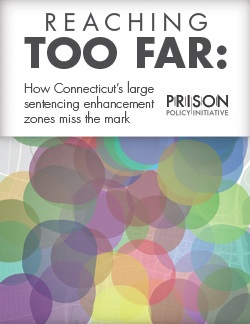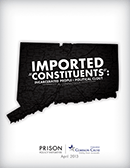Search Results
Your search returned 0 categories and 24 Links.
-
Excessive, unjust, and expensive: Fixing Connecticut's probation and parole problems Prison Policy Initiative and the Katal Center for Equity, Health and Justice, May, 2023“Those who are on probation and parole live in fear of arrest and incarceration for nearly any action that could constitute a violation -- a gross misuse of resources and a disservice to families in Connecticut.”
-
Moving Justice Forward: A Blueprint for the Connecticut Division of Criminal Justice Center for Justice Innovation, January, 2023“Stakeholders expressed great interest in piloting and eventually expanding the use of restorative justice practices in local courts.”
-
New data: The revolving door between homeless shelters and prisons in Connecticut Prison Policy Initiative, February, 2021“1 in 5 people who used homeless shelters in the Connecticut Coalition to End Homelessness' network had been released from prison in the past three years.”
-
Expanding Medicaid Access to Halfway House Residents: Early Qualitative Findings from Connecticut's Experience Urban Institute, December, 2018“Residents no longer have to contend with their fears of returning to the medical unit of a correctional facility for care, and they perceive that Medicaid gives them access to their choice of higher-quality providers.”
-
Decarceration Strategies: How 5 States Achieved Substantial Prison Population Reductions The Sentencing Project, September, 2018(This report summarizes key strategies and practices used by Connecticut, Michigan, Mississippi, Rhode Island, and South Carolina to reduce their prison populations, followed by extensive reviews for each of the five states.)
-
Parole Revocation in Connecticut: opportunities to reduce incarceration Samuel Jacobs Criminal Justice Clinic, September, 2017(The Connecticut Board of Pardons and Paroles revoked parole and imposed a prison sanction in 100% of the hearings observed by the Samuel Jacobs Criminal Justice Clinic in November of 2015.)
-
To Protect and Serve: Trends in State-Level Policing Reform, 2015-2016 Vera Institute of Justice, April, 2017“Colorado, Connecticut, Illinois, Utah and Washington have enacted laws that either limit the use of certain types of force, such as chokeholds, or mandate or strengthen police training on the legal boundaries of justifiable force.”
-
Connecticut Employer Survey Practices and Attitudes: The Hiring of Formerly-Incarcerated Persons and Recommendations for Driving Better Outcomes Malta Justice Initiative Inc., December, 2016“4 in 10 respondents have no experience in hiring ex-offenders and a quarter say their company has a policy against it. Very few (3%) are actively hiring individuals with a criminal record.”
-
"Forced into Breaking the Law": The Criminalization of Homelessness in Connecticut Allard K. Lowenstein International Human Rights Clinic, October, 2016“This cycle of incarceration and homelessness comes at a steep cost to people experiencing homelessness, as well as to taxpayers, all while failing to address the root cause of homelessness: a lack of housing solutions.”
-
It Take a Village: Diversion for Police and Families Vera Institute of Justice, June, 2016“This brief explores the creative, collaborative, and community-focused work being done in Nevada, Connecticut, Nebraska, Michigan, Illinois, and Oregon to find productive responses to youth “acting out.””
-
Juvenile Prisons: National consensus and alternatives Connecticut Juvenile Justice Alliance, August, 2015“Over a 12-month period, OCA found at least 532 physical restraints and 134 uses of mechanical restraints at these facilities.”
-
Seven Out of Ten? Not Even Close. Central Connecticut State University, March, 2015(On average children with incarcerated parents were about three times as likely as non-children with incarcerated parents to become justice-involved, not nearly six times more likely.)
 Reaching too far: How Connecticut's large sentencing enhancement zones miss the mark Prison Policy Initiative, March, 2014“This report shows that the law doesn't work, it cannot possibly work, and that it creates an unfair two-tiered system of justice based on a haphazard distinction between urban and rural areas of the state.”
Reaching too far: How Connecticut's large sentencing enhancement zones miss the mark Prison Policy Initiative, March, 2014“This report shows that the law doesn't work, it cannot possibly work, and that it creates an unfair two-tiered system of justice based on a haphazard distinction between urban and rural areas of the state.” Imported Constituents: Incarcerated People and Political Clout in Connecticut Prison Policy Initiative, April, 2013“Seven of the house districts drawn by the Connecticut General Assembly in 2011 use, to meet their required populations, a substantial number of incarcerated people whose home addresses are in other districts.”
Imported Constituents: Incarcerated People and Political Clout in Connecticut Prison Policy Initiative, April, 2013“Seven of the house districts drawn by the Connecticut General Assembly in 2011 use, to meet their required populations, a substantial number of incarcerated people whose home addresses are in other districts.”-
Juvenile Justice Reform in Connecticut: How Collaboration and Commitment Have Improved Public Safety and Outcomes for Youth Justice Policy Institute, February, 2013“Juvenile Justice Reform in Connecticut highlights the past two decades of Connecticut's successful efforts to improve responses to youth who engage in delinquent behavior and to reduce the number of youth placed into residential facilities”
-
Importing Constituents Prisoners and Political Clout in Connecticut Prison Policy Initiative, March, 2010“In seven Connecticut's house districts more than 5% of the population is actually disenfranchised people who are legal residents of other parts of the state.”
-
Felony Disenfranchisement in Connecticut Sentencing Project, October, 2006
-
Mandatory Minimum Sentences Briefing Connecticut General Assembly, December, 2005“The annual cost of incarceration associated with mandatory minimum sentences is $201.1 million.”
-
Minimum Mandatory Sentence Final Report Connecticut General Assembly, December, 2005“Mandatory minimum sentencing laws were specifically intended to deter offenders and thereby reduce crime (and curb drug use). There is no direct evidence to suggest that the state's mandatory minimum sentencing laws reduced the crime rate (or drug use).”
-
Studies of Voting Behavior and Felony Disenfranchisement Among Individuals in the Criminal Justice System in New York, Connecticut, and Ohio Sentencing Project, September, 2005(Prisoners with felony convictions)
-
Building Bridges: From Conviction to Employment - One Year Later Council of State Governments, February, 2004(contains detailed maps of high incarceration areas in Hartford and New Haven Connecticut)
-
Study of the Imposition of the Death Penalty in Connecticut State of Connecticut Commission on the Death Penalty, January, 2003
-
Impact of Recent Legal Changes in Felon Voting Rights in Five States Profs Uggen and Manza, October, 2002(Connecticut, Delaware, Maryland, New Mexico and Texas)
-
The Private Prison Research Site Charles H. Logan, University of Connecticut, 2000(Author: Private Prisons: Cons and Pros)
Pages Updated On: 20-Apr-2024 - 00:09:59
Links Engine Powered By: Gossamer Threads Inc.
 Reaching too far: How Connecticut's large sentencing enhancement zones miss the mark Prison Policy Initiative, March, 2014
Reaching too far: How Connecticut's large sentencing enhancement zones miss the mark Prison Policy Initiative, March, 2014 Imported Constituents: Incarcerated People and Political Clout in Connecticut Prison Policy Initiative, April, 2013
Imported Constituents: Incarcerated People and Political Clout in Connecticut Prison Policy Initiative, April, 2013